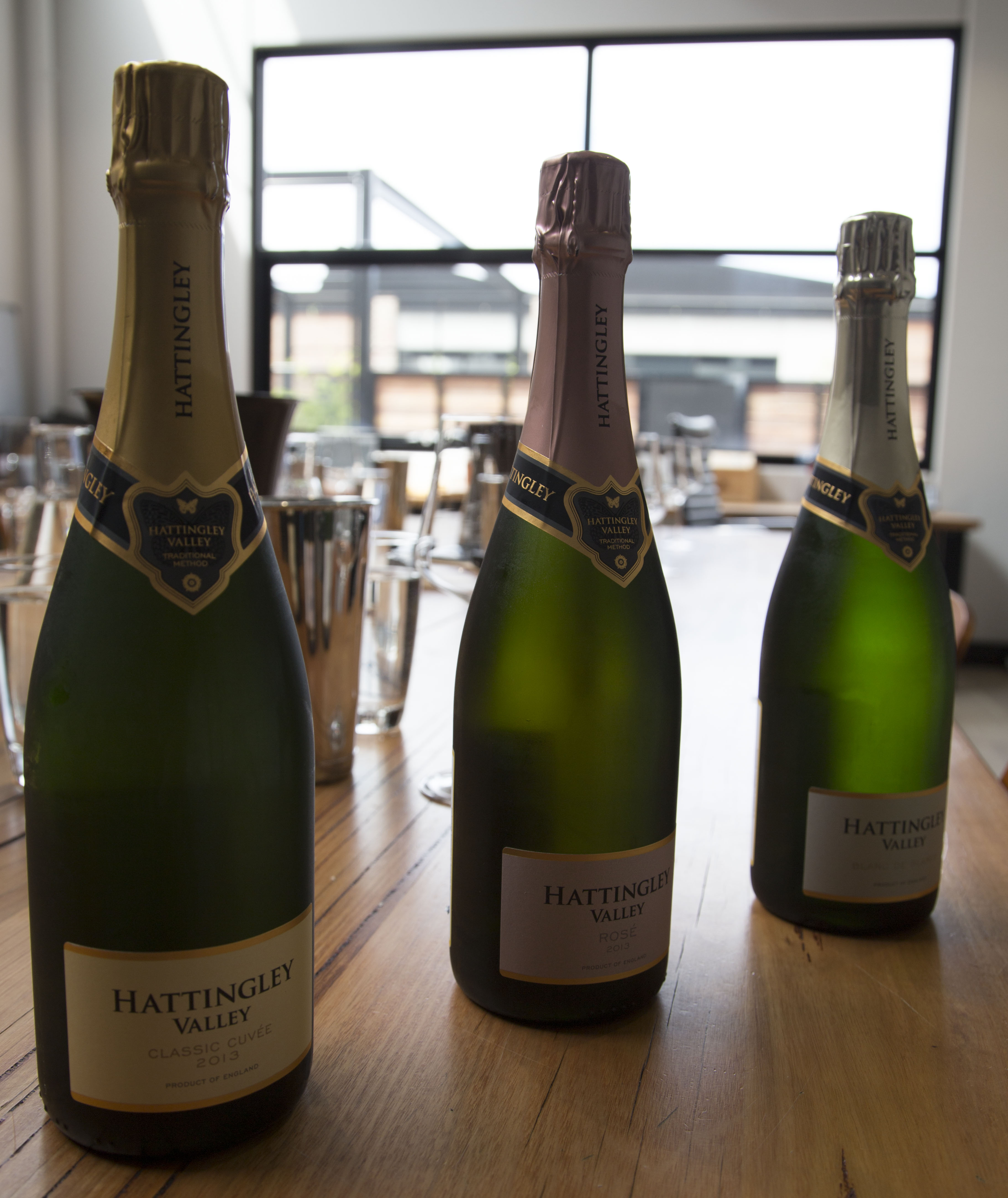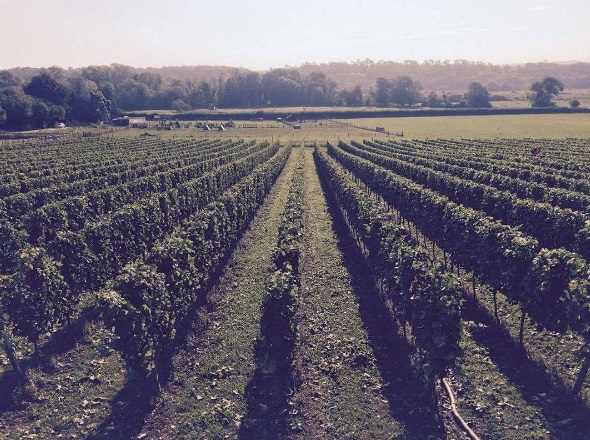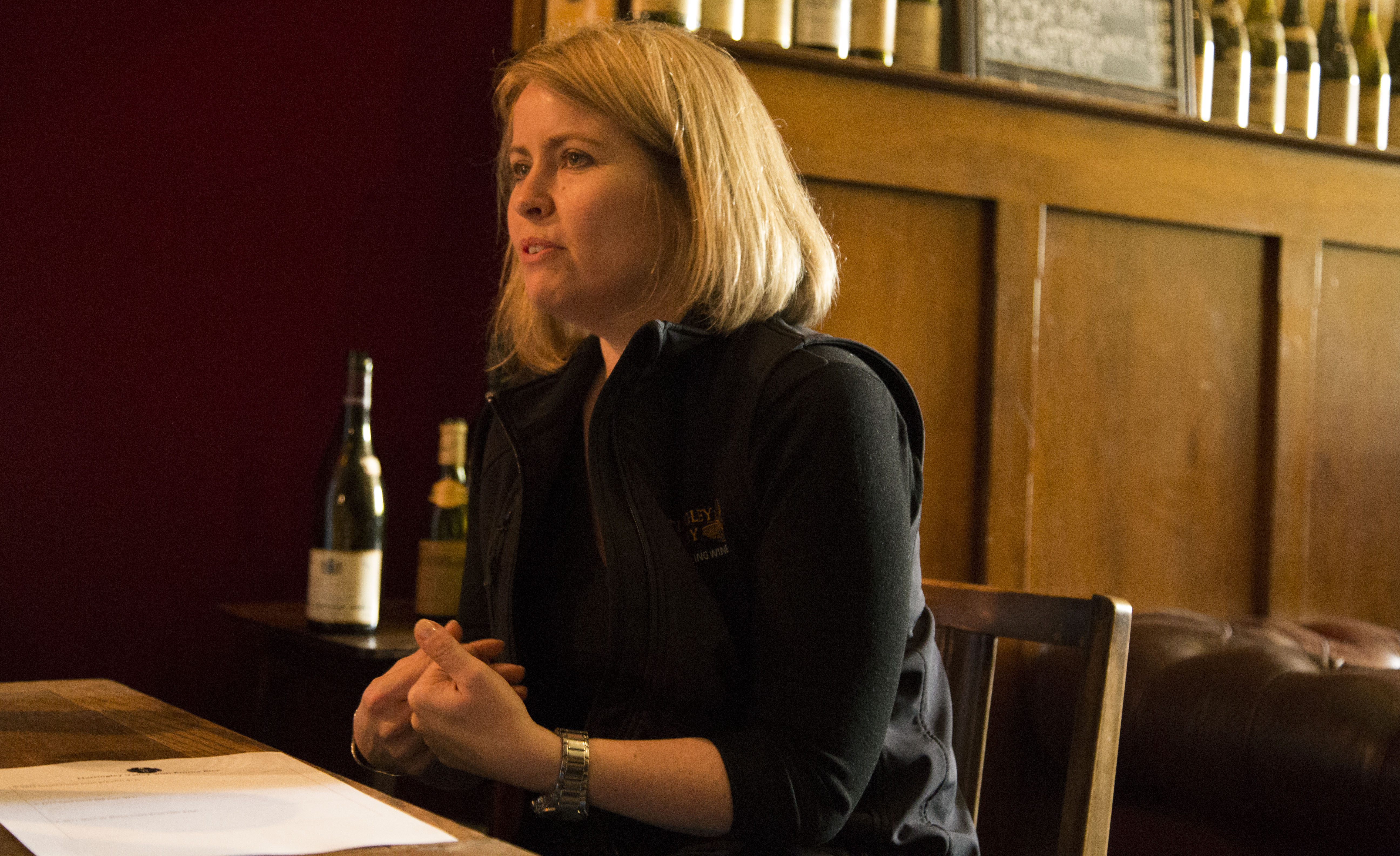by Ed Merrison
“Emma, your brains are not your asset. Your personality and your looks are your assets.” It’s hardly the advice you’re holding out for the day after a double magnum of ’79 Krug has persuaded you to ditch your old life and make a break for the wine business. Whatever else it might be, it’s also way off the mark. Emma Rice is sharper than a swig of Cumbrian Cabernet.
She’s since proved it beyond doubt, having twice earned the UK Winemaker of the Year title and turning Hattingley Valley into a spearhead of the world-class English sparkling scene. It takes deep pockets and nerves of steel to compete when operating in a fledgling industry in a marginal climate. It also takes raw smarts on a grand scale to pull the strands together to create a rich and seamless tapestry. And Emma wouldn’t flinch for a second.
Perhaps all that time spent in the pub initially concealed some of that cleverness; certainly it was enough to sharpen her pool skills at the expense of a university place. Instead she did a catering course and started out in hospitality. Then that fateful Krug came along. “I thought, ‘This is why people spend money on wine’, and I’ve been hooked ever since,” she says.
Furious, though, with the aforementioned job-hunting tip, Emma quit her service role and got a job at Oddbins, before working her way up to the position of sales and marketing coordinator at London-based Burgundy specialist Domaine Direct. Things went a step further when she scored an editor role at Mitchell Beazley and Hugh Johnson’s Pocket Wine Book became “my baby”. “I got so inspired reading about all these wine writers and photographers who were off travelling, looking at wineries and talking to winemakers. I just thought, ‘I want to do that. I don’t want to be sat in an office in Canary Wharf anymore’.” Amid the magic of that little book, the expanding section on English wine caught her eye. Within it, Plumpton College loomed ever larger. And then, in 2003 at the age of 29, she moved to Brighton and joined the first intake to graduate with a full degree in Viticulture & Oenology.

Her first job after Plumpton was supposed to be as lab intern at Cuvaison, in Calistoga at the top end of California’s Napa Valley. Upon arrival she immediately showed the blend of pluck and savvy that’s taken her so far, so fast. “I got there and they said, ‘Well, the oenologist left last week, so now you’re the oenologist. There’s your lab, we’ve got 1,000 tonnes coming in, we’ve got 12 different winemakers, off you go’,” she recalls. “I thought, ‘Oh, OK’. No idea what I was getting myself into.” It was supposed to be a three-month gig but she ended up staying two years. “That was fantastic – a wonderful lifestyle in California. Good wines, nice people. I would’ve stayed there if I could’ve done, but my visa ran out so I had to move on.”
Next destination was Tamar Ridge, then owned by fallen Tasmanian timber giant Gunns. This wretched stint (“The worst experience of my life. Working there was horrible”) turned out to be a blessing in disguise. After just three months, she chucked it in and went back to Blighty to regroup.
This was 2008, and in the intervening years the English wine industry had taken off. Emma seized the opportunity to start her own lab and consulting company, Custom Crush. She also appeared on the radar of ex-City lawyer Simon Robinson, who’d planted a vineyard on his King’s Farm property in Lower Wield, Hampshire. “He asked me to build a winery for him,” recalls Emma. “Every winemaker’s dream is to start from scratch.” So it was that Hattingley Valley was born, with a cutting-edge winery that could accommodate three times the production of the estate’s own vineyard. Just like in Napa, Emma wasn’t going to let the enormity of the task stop her. “I was inexperienced but I was a damn sight more experienced than anyone else. It’s all relative,” she says. “If I’d stayed in California I would not be head winemaker at a winery now. In such a small industry – such a rapidly growing industry with so few qualified people – I was catapulted ahead of where I should’ve been at the time. There was a certain amount of bravado involved when I started out my business.”
A dose of bravado is prerequisite in a climate where wine-growing is as risky and expensive as it is in the UK. This is a place where it rained for 28 days straight in June 2012, a year in which Hattingley Valley made not a drop of wine. This vintage just gone, yields were slashed in half, largely down to a lethal frost that also hit the Loire and Chablis. “Jim, the vineyard manager goes from the severe highs of ‘Oh my God we’ve got a fantastic crop out there’ to ‘Oh shit, it’s going to be frosty’. Managing him and his emotions is one of my biggest jobs.” The whims of nature add to the already considerable costs of a fine sparkling wine program. Emma estimates that Hattingley Valley’s own vineyard output from 2016 exceeded £3,000 (about AU$5,125) per tonne of grapes. To put that into perspective, that same vintage Australia’s cool to temperate regions averaged less than AU$1,200 per tonne.
 So what’s England got going for it? Well, there’s the soil for one thing. The South Downs, where many of the best vineyards of Hampshire, Kent and Sussex are to be found, sit on the same chalky soils on which Champagne’s fame is built. As for the climate, it’s cool and capricious but conditions are held by many to mirror Champagne 20 or so years ago. Climate change may continue to play into English hands. The growing season is longer, too, with British pickers traipsing out in their jeans and thermal underwear a good couple of weeks after their Champenois counterparts. Long, slow ripening gives the grapes depth of flavour that belies their modest sugar levels. It’s more than mere curiosity that’s led the likes of Pommery and Taittinger to dip their toe into English sparkling.
So what’s England got going for it? Well, there’s the soil for one thing. The South Downs, where many of the best vineyards of Hampshire, Kent and Sussex are to be found, sit on the same chalky soils on which Champagne’s fame is built. As for the climate, it’s cool and capricious but conditions are held by many to mirror Champagne 20 or so years ago. Climate change may continue to play into English hands. The growing season is longer, too, with British pickers traipsing out in their jeans and thermal underwear a good couple of weeks after their Champenois counterparts. Long, slow ripening gives the grapes depth of flavour that belies their modest sugar levels. It’s more than mere curiosity that’s led the likes of Pommery and Taittinger to dip their toe into English sparkling.
One way of mitigating against the fickle weather is to source grapes from different parts of the country. Emma has something of an advantage in this. Custom Crush, which she operates from the Hattingley Valley site, takes in grapes, juice and wine from clients right across the country. She also sits on the management committee of the UK Vineyard Association “because I’m nosy and I like to know what’s going on”. She’s firmly opposed to rushing into stricter appellation system that would apply a straitjacket to English winemakers while they’re still getting to grips with the tools at their disposal. “We do a lot of experimentation at Hattingley, which is great, given we’ve got carte blanche to try things.”
Hattingley Valley embraces the freedom of the English Quality Sparkling Wine designation, which means the wines are made from UK-grown grapes from the same principal vine varieties as Champagne, and using the same “traditional method”. The estate has 26 hectares of its own but also takes in grapes from vineyards spread far and wide under various contract winemaking arrangements. “It’s brilliant for me as a winemaker because it gives us a wider palette to choose from when it comes to blending. It’s very much on the Champagne model.”
Site selection is crucial to any winegrower that aspires to greatness, but it’s arguably more so in such a precarious environment for ripening grapes. “If you don’t get that right, then you don’t stand a chance,” says Emma. Hattingley Valley’s two main sites both sit on solid chalk, about 20 to 30cm down. The eponymous vineyard at King’s Farm was planted in 2008 on clay-loam topsoil, at an elevation of 180m. It’s a beautiful site, if a touch exposed. “It produces fantastic quality fruit in terms of ripeness and fruit flavours but the yields are just ridiculous. They’re just so small.” The other key vineyard is Cottonworth, at 40m to 70m elevation. Again, it has loamy topsoil, this time strewn with hunks of flint known as Hampshire diamonds. “That’s our grand-cru site. There are four distinct parcels which produce fantastic quality fruit – some of the best in England, I’d say.”

A defining characteristic of English sparkling wine is the piercing acidity. Winemakers from more conventional climes struggle to get their heads round the numbers. The grapes might be ripe enough to give 11% alcohol while acidity soars at 17g/L. “They can’t comprehend it; it would never happen that you’d get that that much acid and that much sugar at that pH level,” says Emma. “There’s disbelief that it can happen in grapes, but it does in England. In very few other places would you get figures like that, and especially along with the flavour development we get.”
That invigorating acidity is a virtue but only if coaxed into balance. The intensity of flavour in the grapes is one factor in this endeavour. Another is the texture that Hattingley Valley builds into the wines through various techniques. After the fashion of Champagne houses like Krug, Jacquesson and Bollinger, the team doesn’t shy away from exposing the juice to oxygen, which renders it more robust but softer. In a similar vein, Hattingley uses a portion of barrel-fermented wine in all of its cuvées, with old oak favoured because feel, rather than flavour, is the point. That said, the team takes the unusual step of putting the pressings in newer oak. This more phenolic part of the juice is handy for lending weight to the wines, which the acid is more than capable of carrying. Then there’s the use of acid-softening malolactic conversion, which select parcels undergo. Last up comes a well-judged squirt of dosage for taut, knife-edge balance.
“Acidity – searing, tight, bright – is endemic in the wines, making them quite unique in shape and form. Fascinating to see them start coming into the Australian market, and should be on the ‘to do list’ of sparkling wine and Champagne lovers.” Mike Bennie, The Wine Front
The result is wines with great fruit purity, unexpectedly rich mouthfeel, and complexity from skilful blending of varieties, vineyards and winemaking parcels. As for that fabled acid, it gives them tremendous zip but comes across as fine and lingering.
Medals alone don’t tell much of a story, but it’s a measure of their pedigree that all three of the wines now available in Australia – the 2013 Classic Cuvée, 2013 Rosé and 2011 Blanc de Blancs – all won gold at this year’s Champagne and Sparkling Wine World Championships (the latter two were also best in class). This competition, the brainchild of Tom Stevenson, one of the world’s most-respected Champagne authorities, in fact propelled Hattingley Valley to global fame a couple of years back when its 2011 pink fizz won the trophy for best vintage rosé from anywhere.
It all goes to show that looks and personality can go a long way. Seriously, though, what has been the secret of Emma’s success? She had her first inkling that she might have the knack back in Calistoga. This mere novice from across the pond, green as a Hampshire paddock in spring, had the Californians remarking how good it was to have someone in the lab who knew what she was doing. “I thought, ‘Well, I don’t really know what I’m doing. I’m taking each day as it comes and hoping for the best and reading a lot of books’.”
Logical, methodical and matter-of-fact, Emma reckons much of what goes into making good wine is sound organisation and logistics. Press her, and she’ll just about admit that there’s more to it than that. “It’s in the tasting, I think. It’s in the blending. I don’t know how that happens, it just happens. It’s almost an instinct… That sounds a bit arsey, doesn’t it?”
She feels she and her peers are exploring the frontier of winemaking. “It’s still a very exciting project at Hattingley Valley and it’s still very exciting being part of English wine generally.” It’s also a thrill to represent England abroad with the wines now available as far afield as Canada, Japan and Scandinavia. There are no illusions about the size of the task; the wines have to prove time and again that they warrant Champagne prices, when their French neighbours enjoy an enormous head-start in tradition, know-how and reputation. In spite of tremendous support from British wine writers, pubs, merchants and top restaurants, there are still people in Rice’s homeland who either don’t know they make wine, or else have been put off in the grim past by some German hybrid rotgut. “It can be a bit depressing sometimes when you come across people you think are relatively cultured and well educated and they still haven’t tried an English wine or think it’s all crap and acidic and nasty and they don’t want to drink it,” she laments. “Whereas if people try our wine, or Ridgeview or Nyetimber or one of the serious winemakers, then they understand that this is serious wine, especially if you can get them to taste it up against Champagne, blind, and they can’t taste the difference or they think ours is the best.” Ultimately, she’d love to see anyone who usually grabs a Champagne for a special occasion switch instead to English. “We want people to take it seriously because we’re making serious wine. This is not just a bit of fun.”
Of course there’s a lot at stake, and it’ll take plenty more time and effort to make English sparkling the toast of the wine world at large. But attitudes are changing fast, both at home and overseas, and the progress in quality has been little short of astounding. “I never ever thought, when I went to Plumpton to train as a winemaker, that I would ever live in England again. I thought I’d be living my life and career abroad,” Emma reflects. “Now I work half an hour from where I grew up. It’s very cool. I’ve got the best job in the world, really.”
